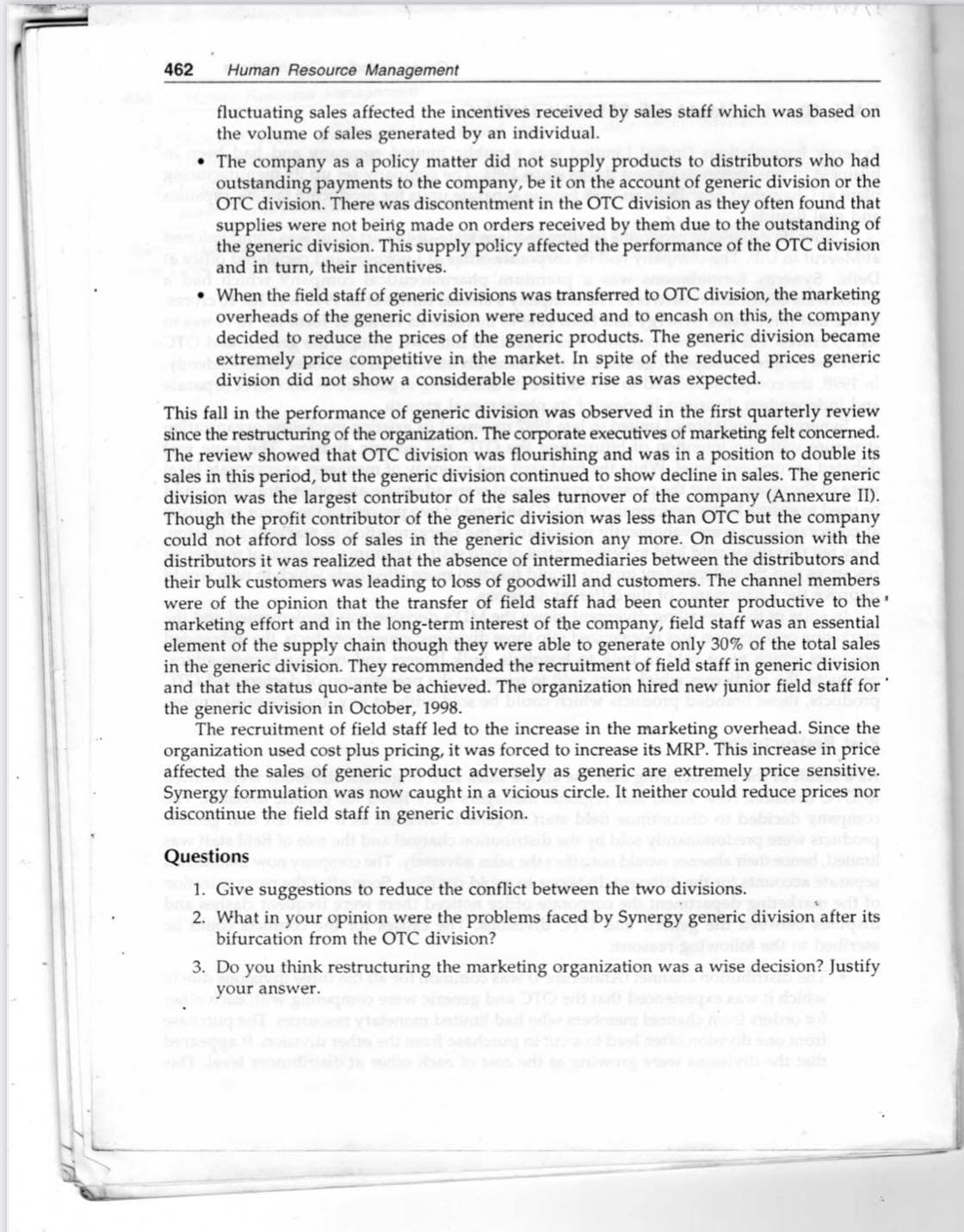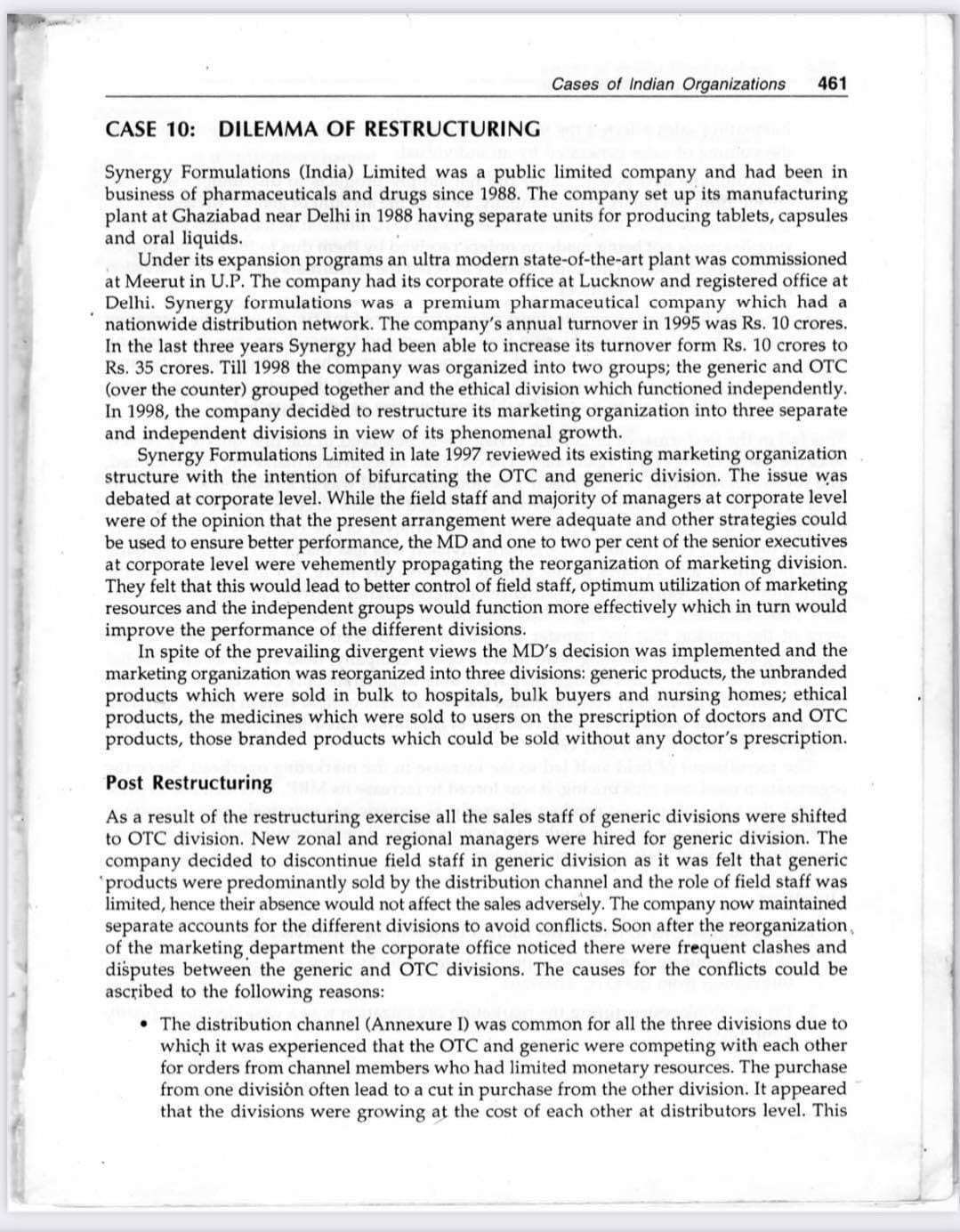1. Give suggestions to reduce the conflict between the two divisions. 2. What in your opinion were the problems faced by Synergy generic division after its bifurcation from the OTC division? 3. Do you think restructuring the marketing organization was a wise decision? Justify your answer.
1. Give suggestions to reduce the conflict between the two divisions. 2. What in your opinion were the problems faced by Synergy generic division after its bifurcation from the OTC division? 3. Do you think restructuring the marketing organization was a wise decision? Justify your answer.
Chapter3: The Marketing Environment
Section3.2: Volkswagen Hits A Bump In The Road
Problem 2C
Related questions
Question
Read the case carefully and answer the questions.
QUESTION :
1. Give suggestions to reduce the conflict between the two divisions.
2. What in your opinion were the problems faced by Synergy generic division after its bifurcation from the OTC division?
3. Do you think restructuring the marketing organization was a wise decision? Justify your answer.

Transcribed Image Text:462
Human Resource Management
fluctuating sales affected the incentives received by sales staff which was based on
the volume of sales generated by an individual.
• The company as a policy matter did not supply products to distributors who had
outstanding payments to the company, be it on the account of generic division or the
OTC division. There was discontentment in the OTC division as they often found that
supplies were not being made on orders received by them due to the outstanding of
the generic division. This supply policy affected the performance of the OTC division
and in turn, their incentives.
• When the field staff of generic divisions was transferred to OTC division, the marketing
overheads of the generic division were reduced and to encash on this, the company
decided to reduce the prices of the generic products. The generic division became
extremely price competitive in the market. In spite of the reduced prices generic
division did not show a considerable positive rise as was expected.
This fall in the performance of generic division was observed in the first quarterly review
since the restructuring of the organization. The corporate executives of marketing felt concerned.
The review showed that OTC division was flourishing and was in a position to double its
sales in this period, but the generic division continued to show decline in sales. The generic
division was the largest contributor of the sales turnover of the company (Annexure II).
Though the profit contributor of the generic division was less than OTC but the company
could not afford loss of sales in the generic division any more. On discussion with the
distributors it was realized that the absence of intermediaries between the distributors and
their bulk customers was leading to loss of goodwill and customers. The channel members
were of the opinion that the transfer of field staff had been counter productive to the'
marketing effort and in the long-term interest of the company, field staff was an essential
element of the supply chain though they were able to generate only 30% of the total sales
in the generic division. They recommended the recruitment of field staff in generic division
and that the status quo-ante be achieved. The organization hired new junior field staff for'
the generic division in October, 1998.
The recruitment of field staff led to the increase in the marketing overhead. Since the
organization used cost plus pricing, it was forced to increase its MRP. This increase in price
affected the sales of generic product adversely as generic are extremely price sensitive.
Synergy formulation was now caught in a vicious circle. It neither could reduce prices nor
discontinue the field staff in generic division.
Questions
1. Give suggestions to reduce the conflict between the two divisions.
2. What in your opinion were the problems faced by Synergy generic division after its
bifurcation from the OTC division?
3. Do you think restructuring the marketing organization was a wise decision? Justify
your answer.

Transcribed Image Text:Cases of Indian Organizations
461
CASE 10: DILEMMA OF RESTRUCTURING
Synergy Formulations (India) Limited was a public limited company and had been in
business of pharmaceuticals and drugs since 1988. The company set up its manufacturing
plant at Ghaziabad near Delhi in 1988 having separate units for producing tablets, capsules
and oral liquids.
Under its expansion programs an ultra modern state-of-the-art plant was commissioned
at Meerut in U.P. The company had its corporate office at Lucknow and registered office at
Delhi. Synergy formulations was a premium pharmaceutical company which had a
nationwide distribution network. The company's annual turnover in 1995 was Rs. 10 crores.
In the last three years Synergy had been able to increase its turnover form Rs. 10 crores to
Rs. 35 crores. Till 1998 the company was organized into two groups; the generic and OTC
(over the counter) grouped together and the ethical division which functioned independently.
In 1998, the company decided to restructure its marketing orga
and independent divisions in view of its phenomenal growth.
Synergy Formulations Limited in late 1997 reviewed its existing marketing organization
structure with the intention of bifurcating the OTC and generic division. The issue was
debated at corporate level. While the field staff and majority of managers at corporate level
were of the opinion that the present arrangement were adequate and other strategies could
be used to ensure better performance, the MD and one to two per cent of the senior executives
at corporate level were vehemently propagating the reorganization of marketing division.
They felt that this would lead to better control of field staff, optimum utilization of marketing
resources and the independent groups would function more effectively which in turn would
improve the performance of the different divisions.
In spite of the prevailing divergent views the MD's decision was implemented and the
marketing organization was reorganized into three divisions: generic products, the unbranded
products which were sold in bulk to hospitals, bulk buyers and nursing homes; ethical
products, the medicines which were sold to users on the prescription of doctors and OTC
products, those branded products which could be sold without any doctor's prescription.
ation into three separate
Post Restructuring
As a result of the restructuring exercise all the sales staff of generic divisions were shifted
to OTC division. New zonal and regional managers were hired for generic division. The
company decided to discontinue field staff in generic division as it was felt that generic
'products were predominantly sold by the distribution channel and the role of field staff was
limited, hence their absence would not affect the sales adversely. The company now maintained
separate accounts for the different divisions to avoid conflicts. Soon after the reorganization,
of the marketing department the corporate office noticed there were frequent clashes and
disputes between the generic and OTC divisions. The causes for the conflicts could be
ascribed to the following reasons:
• The distribution channel (Annexure I) was common for all the three divisions due to
which it was experienced that the OTC and generic were competing with each other
for orders from channel members who had limited monetary resources. The purchase
from one división often lead to a cut in purchase from the other division. It appeared
that the divisions were growing at the cost of each other at distributors level. This
Expert Solution
This question has been solved!
Explore an expertly crafted, step-by-step solution for a thorough understanding of key concepts.
This is a popular solution!
Trending now
This is a popular solution!
Step by step
Solved in 2 steps

Recommended textbooks for you



